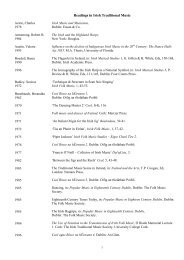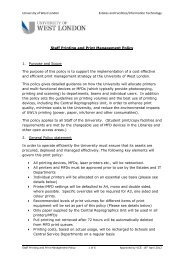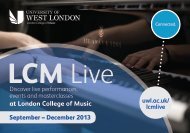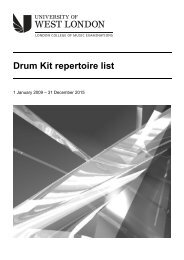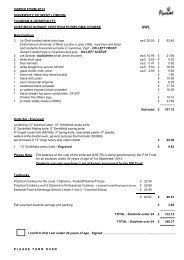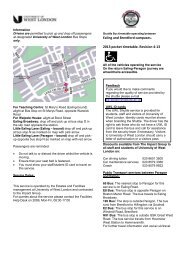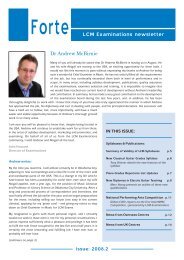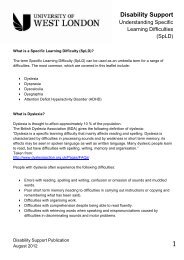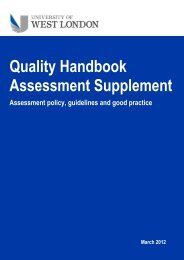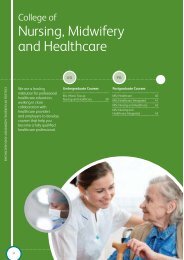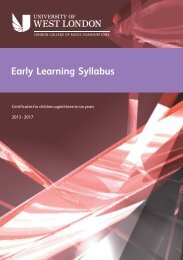Electronic keyboard and organ repertoire list - University of West ...
Electronic keyboard and organ repertoire list - University of West ...
Electronic keyboard and organ repertoire list - University of West ...
Create successful ePaper yourself
Turn your PDF publications into a flip-book with our unique Google optimized e-Paper software.
<strong>Electronic</strong> Keyboard:General Guidelines1. C<strong>and</strong>idates are required to bring their own <strong>keyboard</strong> to the examination <strong>and</strong> will be expected to usethe internal speakers <strong>of</strong> the <strong>keyboard</strong>. However, external speakers may be used provided they areset up <strong>and</strong> dismantled speedily <strong>and</strong> efficiently within the time allotted for the examination.C<strong>and</strong>idates using their own <strong>keyboard</strong> should also provide a music rest, adaptor/batteries, st<strong>and</strong> <strong>and</strong>stool (if required). A table <strong>and</strong> power source will be provided. Examiners will not assist with settingup or registering the instrument.2. A modern instrument that features a range <strong>of</strong> programmable functions is expected to be used atdiploma level. These should include note <strong>and</strong> data sequencing, drum/percussion programming,programmable footswitches, accompaniment pattern/style composer, registration memory, autochord harmony <strong>and</strong> performance pads. The instrument’s accompaniment system should be able torecognise advanced chord extensions (e.g. add 9/2, major <strong>and</strong> dominant 9ths,diminished/augmented 5ths, 13ths etc) <strong>and</strong> all common chord extensions <strong>and</strong> be used in bothfingered/multi-fingered mode <strong>and</strong> full <strong>keyboard</strong>/pianist mode throughout the examination.3. The use <strong>of</strong> a sustain pedal <strong>and</strong> programmable function switches (foot switches) is required at thislevel. Secure musical dynamics <strong>and</strong> expression through the use <strong>of</strong> a dedicated expression pedal isexpected, as is the further control <strong>of</strong> expressive dynamics <strong>and</strong> tonal variations through <strong>keyboard</strong>touch.4. If the c<strong>and</strong>idate adheres to the score in a technically competent manner <strong>and</strong> gives a musicalperformance, full marks may be achieved. However, a higher level <strong>of</strong> pass can be achieved byexploiting the instrument’s musical <strong>and</strong> technological potential <strong>and</strong> by making musically creative <strong>and</strong>innovative alterations to a score or performance.5. In all diplomas, the c<strong>and</strong>idate is expected to make full use <strong>of</strong> the instrument’s facilities <strong>and</strong> shouldinclude any programmable feature that will facilitate a complete <strong>and</strong> competent performance. Musicperformed should only use on-board functions, although the use <strong>of</strong> an external data storage/retrievaldevice is permitted. The use <strong>of</strong> commercially available MIDI files or backing tracks is only permittedif the full potential <strong>of</strong> the instrument has been realised <strong>and</strong> the desired effect cannot be achieved byany other means. Permission to use these must be sought from the Chief Examiner in Music inadvance <strong>of</strong> the examination, <strong>and</strong> his approval letter must be brought to the exam.6. Scales <strong>and</strong> arpeggios should be played using a clear tone – preferably a piano or electric pianovoice, with no sustain. Scales should be played with a sense <strong>of</strong> musicality <strong>and</strong> purpose. The first aim<strong>of</strong> playing scales/arpeggios is to achieve accuracy, evenness <strong>and</strong> clarity. For the guidance <strong>of</strong>c<strong>and</strong>idates the recommended tempo range is shown. However, it should be remembered thataccuracy <strong>and</strong> clarity are more important than pure speed. All scales/arpeggios must be played frommemory. A copy <strong>of</strong> the music may be used for the ALCM exercise.7. ‘Single Finger’ chord recognition should only be used to create a specific effect <strong>and</strong> the examinermay ask the c<strong>and</strong>idate to justify its use.8. Copies <strong>of</strong> all music performed should be provided for the examiner, including own compositions,arrangements <strong>and</strong> sequencer scores. These may be h<strong>and</strong>-written or prepared with a score-writingcomputer programme such as Finale or Sibelius.9. The c<strong>and</strong>idate must be able to demonstrate that any sequenced data or programmed function orfeature was executed by him/her.Grateful thanks are due to Tony Pegler, the principal syllabus compiler.4




